In the heart of American automotive history, one name resonates with the spirit of hard work, adventure, and the open road: Ford. From the rugged ranches of the West to the bustling streets of growing cities, Ford trucks have been an integral part of the American landscape for over a century. These vehicles, built “Ford Tough,” have hauled timber, transported families, and even served as icons of popular culture. But it’s not just the new models that turn heads. Classic Ford trucks, with their timeless designs and legendary reliability, hold a special place in the hearts of enthusiasts and collectors.
What makes these vintage Ford trucks so enduringly appealing? Is it the nostalgia they evoke, the sheer craftsmanship of their design, or the thrill of owning a piece of automotive history? For many, it’s a combination of all these factors, plus the undeniable fact that classic Ford trucks are often surprisingly practical and reliable even today. This leads to the question: Could a classic Ford truck be the best Ford truck for you?
In this exploration of history of classic Ford trucks, we’ll delve into their fascinating history, from the early pioneers like the Model TT and Model AA to the iconic F-Series that revolutionized the truck industry. We’ll uncover the stories behind these legendary vehicles, examine their unique features, and offer insights into what makes them such sought-after treasures. Whether you’re a lifelong Ford enthusiast, a history buff, or simply curious about these vintage workhorses, prepare to be captivated by the enduring legacy of classic Ford trucks.
Early Ford Truck Models: Forging a Path in the American Automotive Landscape
The story of Ford trucks is a tale of innovation, adaptability, and unwavering commitment to meeting the needs of hardworking Americans. In the early 20th century, Ford’s pioneering trucks, the Model TT and Model AA, emerged as indispensable tools for businesses, farmers, and tradespeople across the nation. These early models not only laid the groundwork for Ford’s dominance in the truck market but also played a crucial role in shaping the American automotive landscape.
The Model TT (1917-1927) – Ford’s Entry into the Truck Market
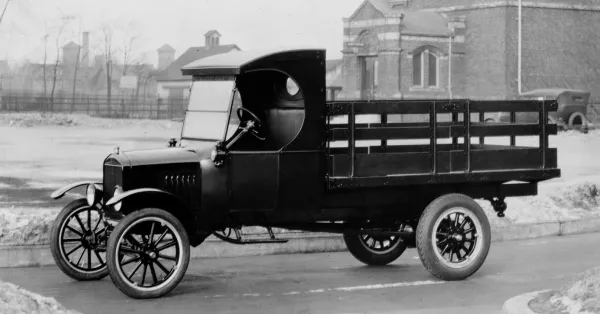
In 1917, Ford introduced the Model TT, marking its entry into the commercial truck market. Based on the immensely popular Model T car, the TT was engineered to handle heavier loads and more demanding tasks. It featured a reinforced frame, a sturdier rear axle, and a one-ton carrying capacity, making it a practical and affordable option for businesses and individuals alike.
One of the most innovative aspects of the Model TT was its modular design. Unlike the Model T, which was sold as a complete vehicle, the TT was offered as a rolling chassis. This allowed customers to customize their trucks with a wide variety of body styles to suit their specific needs. Farmers could opt for a flatbed to haul produce, while businesses could choose a panel truck for deliveries. The Model TT’s versatility made it an instant hit, quickly becoming a familiar sight on American roads and farms.
Impact and Legacy of the Model TT:
The Model TT’s impact on the automotive industry was significant. It democratized truck ownership, making it accessible to a broader range of people and businesses. Its rugged construction and reliable performance earned it a reputation for dependability, which further solidified Ford’s position as a leading automaker. The Model TT’s success also paved the way for future Ford truck models, including the iconic F-Series.
The Model AA (1928-1931) – Building on Success with Innovation
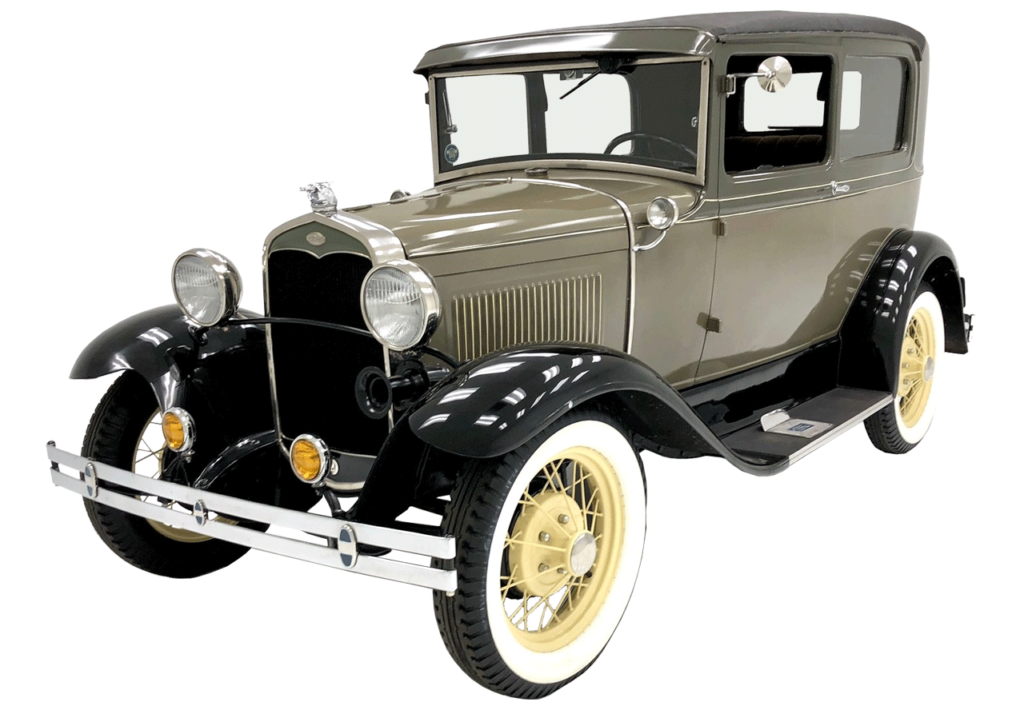
Building on the success of the Model TT, Ford introduced the Model AA in 1928. This updated model featured a more powerful four-cylinder engine, improved brakes, and a redesigned front axle, enhancing its performance and capabilities. The Model AA also offered a wider range of body styles, including pickup trucks, panel trucks, station wagons, and even ambulances.
Like its predecessor, the Model AA was embraced by a diverse range of users, from farmers and ranchers to delivery companies and emergency services. Its adaptability and reliability made it a valuable asset in a variety of industries, further solidifying Ford’s reputation as a leading truck manufacturer.
Innovations and Advancements:
The Model AA incorporated several key innovations that set it apart from its competitors. Its four-wheel brakes, a significant improvement over the two-wheel brakes of the Model TT, provided better stopping power and enhanced safety. The Model AA also featured a more comfortable cab with improved seating and a wider windshield, making it a more pleasant vehicle to drive. These advancements, combined with its versatility and reliability, made the Model AA a popular choice for businesses and individuals across the country.
The Enduring Legacy of the Early Ford Trucks:
The Model TT and Model AA may have been replaced by more modern designs, but their influence on the automotive industry and American culture cannot be overstated. These early Ford trucks helped to shape the American landscape, providing reliable transportation for goods and people during a time of rapid growth and expansion.
Their legacy lives on in the countless classic Ford trucks that continue to be cherished by collectors and enthusiasts today. These vintage vehicles serve as a reminder of a bygone era, a time when trucks were built to last and craftsmanship was valued above all else. Whether you’re a die-hard Ford fan or simply appreciate the history of American automobiles, the Model TT and Model AA are fascinating examples of Ford’s early innovation and its unwavering commitment to building vehicles that meet the needs of the people.
The Golden Age of Ford Trucks
The mid-20th century marked a transformative era for Ford trucks, a period of innovation and design that solidified their place in American culture and paved the way for their enduring popularity. This was the Golden Age of Ford trucks, a time when iconic models like the F-100, the fourth-generation F-Series, and the fifth-generation F-Series redefined what a pickup truck could be.
The 1953-1956 F-100 – A Design Revolution That Could Be the Best Ford Truck for You
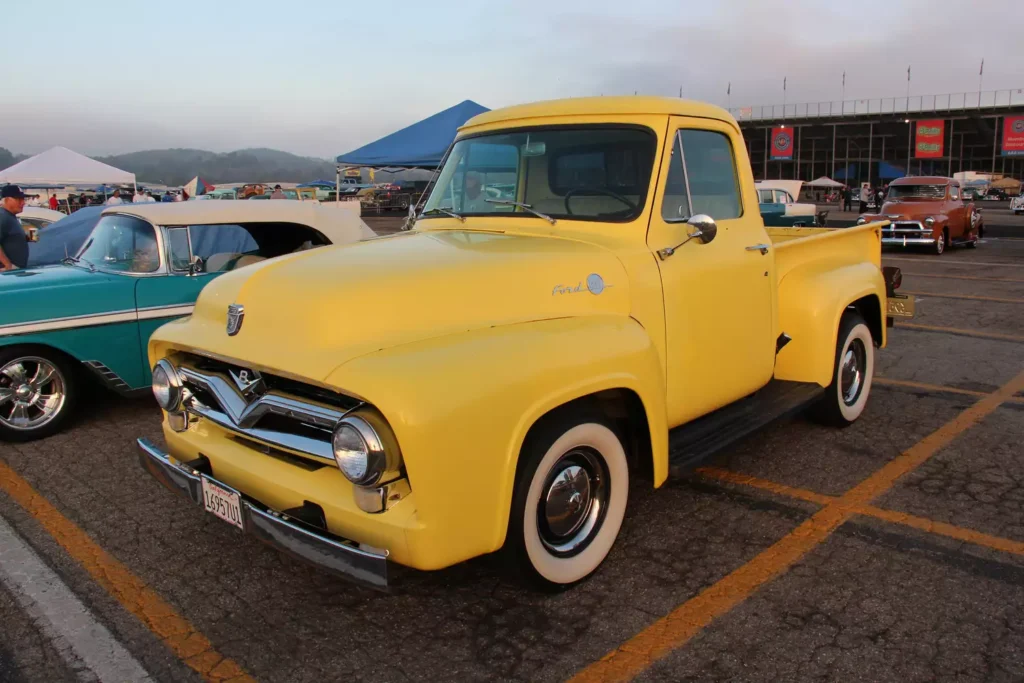
The 1953-1956 F-100 was a turning point in Ford truck history, a design revolution that set a new standard for style and functionality. This generation of F-Series trucks ditched the boxy, utilitarian look of its predecessors in favor of a sleek, aerodynamic design with rounded lines, a wraparound windshield, and integrated headlights. The F-100 was more than just a pretty face, though. Its innovative design improved visibility, aerodynamics, and driver comfort, making it a more enjoyable and practical vehicle to drive.
The F-100 quickly became a cultural icon, gracing the pages of magazines, appearing in movies and television shows, and becoming a favorite for customization. Hot rodders and customizers embraced the F-100’s stylish lines and versatile platform, transforming it into a wide array of unique creations. From lowered street rods to high-performance drag racers, the F-100 proved its versatility and cemented its place as a classic.
Even today, a well-preserved or tastefully restored F-100 commands attention and admiration. Its timeless design and enduring popularity make it a sought-after collector’s item and a potential contender for the title of the best Ford truck for those who appreciate vintage style and a touch of Americana.
The 1961-1966 F-Series – Power and Performance for Work and Play
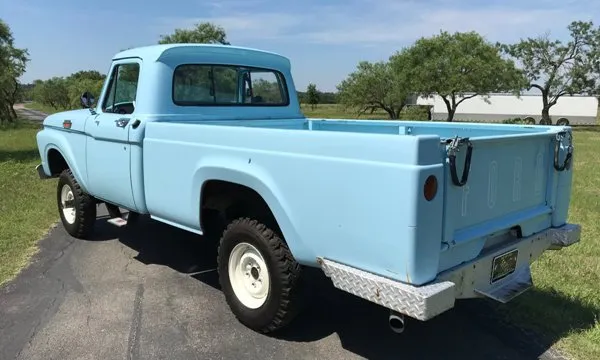
The fourth-generation F-Series, produced from 1961 to 1966, built upon the success of its predecessors by offering increased power, performance, and versatility. This generation saw the introduction of the powerful FE-series V8 engines, which provided the muscle needed for hauling heavy loads and tackling demanding tasks. With options ranging from the 292 cubic-inch Y-block V8 to the mighty 390 cubic-inch FE V8, the F-Series catered to a wide range of needs and preferences.
Ford also recognized the growing trend of using trucks for recreational purposes. The fourth-generation F-Series introduced features like the Camper Special package, designed for those who wanted to explore the great outdoors with their trucks. This package included heavy-duty suspension, extra cooling capacity, and wiring for camper hookups, making the F-Series a versatile vehicle that could seamlessly transition from worksite to campsite.
The 1973-1979 F-Series – “Built Ford Tough,” the Epitome of Classic Ford Trucks
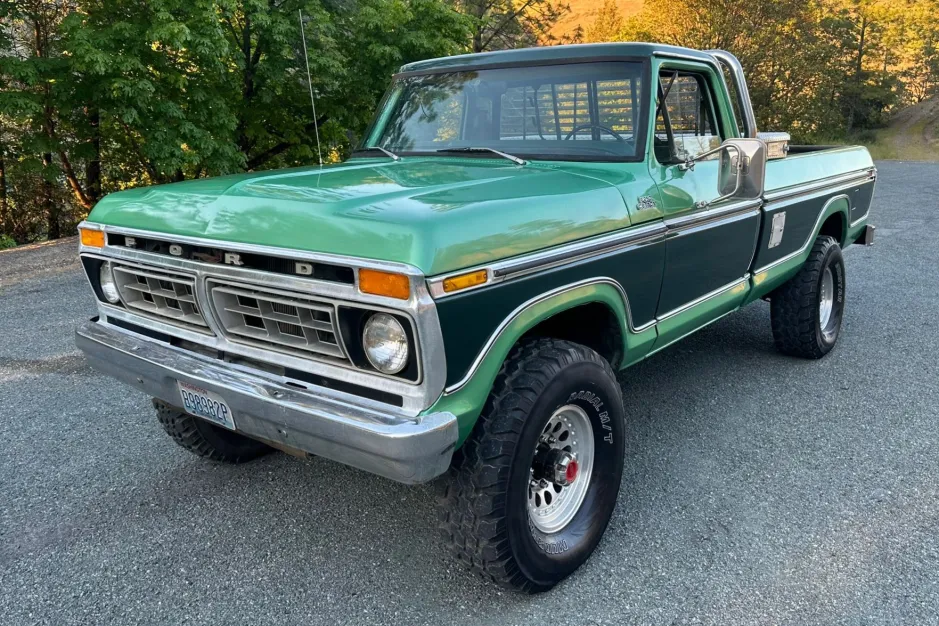
The fifth-generation F-Series, produced from 1973 to 1979, solidified Ford’s reputation for building tough, dependable trucks. This generation embraced a more rugged, utilitarian design with a focus on durability and functionality. The “Built Ford Tough” slogan, introduced during this era, perfectly captured the essence of these trucks.
The fifth-generation F-Series featured a robust frame, a reinforced cab, and a wide range of heavy-duty options, making it a popular choice for contractors, farmers, and anyone who needed a reliable workhorse. Its no-nonsense design and proven reliability earned the loyalty of countless owners who depended on their F-Series trucks to get the job done, no matter the conditions.
Today, the 1973-1979 F-Series remains a beloved classic among truck enthusiasts. Its ruggedness, simplicity, and timeless appeal make it a popular choice for restoration projects and a testament to Ford’s enduring commitment to building trucks that can handle anything life throws at them.
The Timeless Appeal of Vintage Ford Trucks
In a world of sleek, modern vehicles packed with technology, the allure of classic Ford trucks may seem puzzling at first. Yet, their enduring popularity speaks volumes about their unique appeal, transcending generations and trends. These vintage workhorses offer a blend of nostalgia, timeless design, proven reliability, and the potential for rewarding projects that resonate with enthusiasts and collectors alike.
Nostalgia and the Romance of the Open Road: Classic Ford trucks evoke a sense of nostalgia for a simpler time, a bygone era of Americana when trucks were built to last and driving was a more tactile experience. The sight of a vintage F-Series rumbling down the road conjures up images of family road trips, rural landscapes, and a time when life moved at a slower pace. For many, owning a classic Ford truck is like owning a piece of history, a tangible connection to the past that sparks fond memories and a sense of adventure.
Timeless Design that Turns Heads: The design of classic Ford trucks is simply iconic. Whether it’s the elegant curves of the 1950s F-100, the muscular stance of the 1960s models, or the rugged simplicity of the 1970s F-Series, these trucks exude a timeless charm that transcends fleeting trends. Their clean lines, chrome accents, and functional design elements have a beauty that stands the test of time, making them instantly recognizable and admired even by those who aren’t car enthusiasts.
Reliability Born from “Built Ford Tough”: Ford trucks have long been synonymous with durability and reliability. This reputation for toughness extends to their classic models, which, with proper maintenance and care, can continue to run smoothly for decades. Many classic Ford trucks still serve as daily drivers, workhorses on farms and ranches, or dependable project vehicles. Their robust construction and simple mechanics make them easier to maintain and repair than many modern vehicles, adding to their appeal for those who value practicality and self-sufficiency.
The Joy of Restoration and Personalization: For many enthusiasts, the allure of classic Ford trucks lies in the potential for restoration and personalization projects. Taking a rusty, neglected truck and transforming it into a gleaming showpiece is a rewarding challenge that allows owners to express their creativity and mechanical skills. The thriving aftermarket for classic Ford truck parts offers a vast array of options for customization, from engine upgrades and suspension modifications to interior enhancements and custom paint jobs.
A Thriving Community of Passionate Enthusiasts: The classic Ford truck community is a vibrant and welcoming space where owners and enthusiasts come together to share their knowledge, experiences, and passion for these vintage vehicles. Car shows, swap meets, online forums, and social media groups provide platforms for connecting with fellow enthusiasts, exchanging tips and advice, and showcasing their prized possessions. This sense of community adds another layer of enjoyment to owning a classic Ford truck, fostering friendships and camaraderie among like-minded individuals.
Investment Potential and the Growing Collector Market: While not the primary motivation for most owners, classic Ford trucks can also be a sound investment. The value of well-preserved or meticulously restored examples has been steadily appreciating over the years. As these trucks become rarer, their desirability and value are likely to continue to increase. This makes owning a classic Ford truck not just a hobby, but potentially a smart financial decision for those who choose wisely and invest in quality restoration.
Tips for Buying and Restoring Classic Ford Trucks
Embarking on the journey of owning and restoring a classic Ford truck is a rewarding endeavor filled with both challenges and triumphs. Whether you envision a meticulously restored showpiece or a reliable daily driver with vintage charm, careful planning and informed decisions are crucial to a successful outcome.
Where to Find Your Dream Classic Ford Truck:
- Online Marketplaces: The internet has opened up a vast world of classic car buying opportunities. Websites like eBay Motors, Craigslist, and Bring a Trailer are bustling marketplaces where you can find a wide array of vintage Ford trucks, often with detailed descriptions and photos. These platforms offer convenience and a vast selection, but be sure to research sellers thoroughly and ask questions to verify the truck’s condition and history.
- Classic Car Dealers: Reputable classic car dealers specialize in vintage vehicles and often have a curated selection of well-maintained classic Ford trucks. These dealers can provide valuable expertise and may offer warranties or financing options. However, expect to pay a premium for their services and inventory.
- Auctions: Both online and in-person auctions can be exciting venues to find rare and unique classic Ford trucks. However, it’s essential to do your homework before bidding. Research the truck’s history, condition, and estimated value to avoid overpaying or purchasing a vehicle with hidden issues.
- Word of Mouth: Networking with fellow classic Ford truck enthusiasts, mechanics, and restoration experts can be a valuable resource. They often know about trucks that haven’t yet hit the market or can offer insights into specific models and their quirks. Attend car shows, swap meets, and online forums to connect with the community and expand your network.
What to Look For When Buying:
- Condition: Thoroughly inspect the truck’s overall condition, paying close attention to the body, frame, engine, and interior. Look for signs of rust, damage, previous repairs, and any evidence of neglect. A detailed inspection can reveal potential problems and help you negotiate a fair price.
- Originality: Determine how much of the truck is original. Original parts can be valuable to collectors, but modifications may not be detrimental if done tastefully. Consider your goals for the truck – do you want a fully original restoration or a personalized project with modern upgrades?
- Documentation: Request maintenance records, ownership history, and any restoration documentation available. These documents can provide valuable insights into the truck’s past and help you verify its authenticity.
- Mechanical Soundness: Always have a trusted mechanic inspect the truck before purchasing. They can assess the engine, transmission, brakes, suspension, and other critical components. A pre-purchase inspection can identify potential issues and save you from costly surprises down the road.
- Price: Compare prices of similar models in comparable condition to ensure you’re getting a fair deal. Factor in potential restoration costs, which can vary significantly depending on the truck’s condition and your desired level of restoration.
Tips for Restoring Your Classic Ford Truck:
- Set a Realistic Budget: Restoration can be a costly endeavor. Determine a budget that aligns with your financial capabilities and the scope of the project. Be prepared for unexpected expenses and allow for some flexibility.
- Research Your Model: Thoroughly research your specific model year and any unique restoration challenges it may present. Online forums, books, and restoration guides can be invaluable resources.
- Prioritize Safety: Address mechanical issues that affect safety first, such as brakes, steering, and suspension. Ensuring the truck is safe to drive should be your top priority.
- Gather Resources: Locate reputable suppliers for parts, tools, and restoration advice. Building a network of trusted experts can make the restoration process smoother and more enjoyable.
- Start Small: Begin with manageable tasks to gain confidence and experience before tackling major projects. This will help you build your skills and avoid feeling overwhelmed.
- Join the Community: Connect with other classic Ford truck owners through online forums, social media groups, and local clubs. The community is a wealth of knowledge, support, and inspiration.
Restoration is a Journey, Not a Race:
Remember, restoring a classic Ford truck is a journey, not a race. Enjoy the process, learn as you go, and don’t be afraid to ask for help when needed. The satisfaction of bringing a vintage Ford truck back to life is immeasurable.
Conclusion
From their humble beginnings as workhorses designed for utility to their current status as sought-after collector’s items, classic Ford trucks have left an undeniable mark on the automotive world. Their rich history spans decades, each generation contributing to the legacy of innovation, reliability, and timeless design that defines the Ford truck brand.
Whether it’s the pioneering spirit of the Model TT and Model AA, the revolutionary style of the 1950s F-100, the power and versatility of the 1960s models, or the rugged durability of the “Built Ford Tough” era, classic Ford trucks continue to capture the imagination and admiration of enthusiasts worldwide.
These vintage vehicles offer more than just a nostalgic glimpse into the past. They represent a tangible connection to American automotive history, a symbol of craftsmanship and ingenuity that continues to inspire. For many, owning a classic Ford truck is a dream come true, a chance to experience the thrill of driving a piece of automotive history.
If you’ve ever been captivated by the sight of a gleaming vintage Ford truck cruising down the highway or have dreamed of restoring one to its former glory, perhaps it’s time to consider turning that dream into reality. Maybe a classic Ford truck is the best Ford truck for you.
We invite you to share your own stories and memories of classic Ford trucks. Have you ever owned one? Restored one? Or simply admired their timeless beauty from afar? Let us know in the comments below! Your passion and experiences are part of the rich tapestry that celebrates the enduring legacy of these iconic vehicles.